LG Electronics USA TBLT20A TABLET PC WITH INTEL WIRELESS MINI-PCI User Manual 1
LG Electronics USA TABLET PC WITH INTEL WIRELESS MINI-PCI 1
Contents
- 1. User Manual 1
- 2. User Manual 2
- 3. User Manual 3
- 4. User Manual 4
User Manual 1
- 1 -
User’s guide............................................................................................. 7
Important Safety Instructions ................................................................. 8
Selecting a place to work............................................................................ 8
Using the battery pack ............................................................................... 9
Replacing and disposing of the backup (standby) battery .............................. 10
Connecting to an AC power source ............................................................. 11
Using the computer ................................................................................. 12
Using the computer ................................................................................. 13
Upgrading the computer ........................................................................... 15
Upgrading the computer ........................................................................... 15
Carrying and storing the computer ............................................................. 16
Preventing data lose (handling hard disk drives) .......................................... 17
Ergonomic information ............................................................................. 18
For Australian Users .............................................................................. 19
Laser compliance statement .................................................................. 20
Overview ............................................................................................... 21
Package contents .................................................................................... 21
Components ........................................................................................... 22
- 2 -
Front view .............................................................................................. 22
Rear view ............................................................................................... 23
Left view ................................................................................................ 23
Right view .............................................................................................. 24
Status indicators ..................................................................................... 24
Using LCD panel ...................................................................................... 26
Opening LCD Panel .................................................................................. 26
Using Tablet mode................................................................................... 26
Using notebook mode............................................................................... 29
Using Screen rotation............................................................................... 30
Using Touch panel ................................................................................... 32
Using Pen (attached pen in tilt / offered extra pen) ...................................... 33
Exchange the pen point (offered Full size digital pen).................................... 37
Basics .................................................................................................... 39
Using the battery pack ............................................................................. 39
Using the AC adapter ............................................................................... 43
Connecting the AC adapter to an AC outlet (100~240V) ................................ 43
Connecting AC adapter to the power device................................................. 43
Opening and positioning the LCD panel....................................................... 44
Power On ............................................................................................... 44
Turning the power on and off .................................................................... 44
Turning on the computer .......................................................................... 44
Turning off the computer .......................................................................... 47
Using Windows XP ................................................................................... 49
Overview................................................................................................ 49
Using Tablet PC ....................................................................................... 50
Overview................................................................................................ 50
- 3 -
Using Tablet PC Tutorials .......................................................................... 51
Tablet PC Tutorials................................................................................... 51
Using Tablet PC application programs ......................................................... 52
Sticky Notes ........................................................................................... 52
Windows Journals .................................................................................... 52
Help and Support .................................................................................... 53
Windows XP desktop ................................................................................ 54
Start menu ............................................................................................. 55
Changing the look of the Start menu .......................................................... 55
Changing the pinned items in the Start menu .............................................. 55
Showing the recently used items on the Start menu ..................................... 55
Control Panel .......................................................................................... 56
Setting up Local Area Network (LAN) connections......................................... 57
Using Wireless LAN .................................................................................. 59
Connecting and using the wireless network ................................................. 59
Using IP Operator .................................................................................... 60
Changing the Themes and Desktop background ........................................... 61
Using the Windows Classic Theme.............................................................. 61
Using a different theme ............................................................................ 62
Changing the desktop background ............................................................. 62
Setting the Screen Saver .......................................................................... 63
Taskbar.................................................................................................. 63
Desktop cleanup...................................................................................... 63
Using the Power Options........................................................................... 64
Power Options Properties .......................................................................... 64
Power Options Properties .......................................................................... 65
Advanced tab.......................................................................................... 67
Power Meter ........................................................................................... 67
System Hibernation ................................................................................. 68
Using ez menu ........................................................................................ 68
Using pen to input (attached pen in tilt / offered extra pen)........................... 70
- 4 -
Using pen to input (When inputting on notepad) .......................................... 70
Defining font size..................................................................................... 71
Attaching external devices ........................................................................ 72
Attaching a USB device ............................................................................ 72
Attaching an external monitor ................................................................... 72
Attaching an IEEE 1394 device (Option)...................................................... 73
Using Battery Miser.................................................................................. 73
Input/Output......................................................................................... 75
Using the keyboard.................................................................................. 75
Component............................................................................................. 75
Modifier and special function keys .............................................................. 77
Hot keys ................................................................................................ 78
Using the touch pad (Mouse)..................................................................... 80
Moving the pointer on the screen ............................................................... 81
Making the selection (Click) ...................................................................... 81
Double-click (Run) ................................................................................... 82
Drag and drop......................................................................................... 83
Using the scroll up/down function .............................................................. 85
System Setup......................................................................................... 86
Starting the system setup......................................................................... 86
Keys used in the system setup .................................................................. 86
Setting a password .................................................................................. 87
Setting a supervisor password ................................................................... 88
Setting a user password ........................................................................... 89
Changing or removing the password........................................................... 90
Recovering the factory default settings ....................................................... 91
- 5 -
System Recovery..................................................................................... 92
Using Full Recovery ................................................................................. 92
Driver Installation.................................................................................... 96
Installing memory ................................................................................... 97
About memory ........................................................................................ 97
Before installing memory .......................................................................... 97
Purchasing memory ................................................................................. 98
Installing memory ................................................................................... 98
Inserting SD Memory Card.......................................................................101
Removing SD Memory Card......................................................................101
Features............................................................................................... 102
Model ...................................................................................................102
Processor ..............................................................................................102
Memory ................................................................................................102
BIOS ROM .............................................................................................102
Storage devices......................................................................................102
External I/O Interfaces............................................................................103
Display .................................................................................................103
Sound...................................................................................................103
LCD ......................................................................................................103
Modem..................................................................................................103
LAN ......................................................................................................103
Power specification.............................................................................. 104
AC Adapter (Free Voltage) .......................................................................104
Battery Pack (Li-Ion)...............................................................................104
Charging time ........................................................................................104
Battery Life............................................................................................104
Backup (standby) battery ........................................................................104
Operating environment........................................................................ 105
Operating ..............................................................................................105
- 6 -
Non-operating........................................................................................105
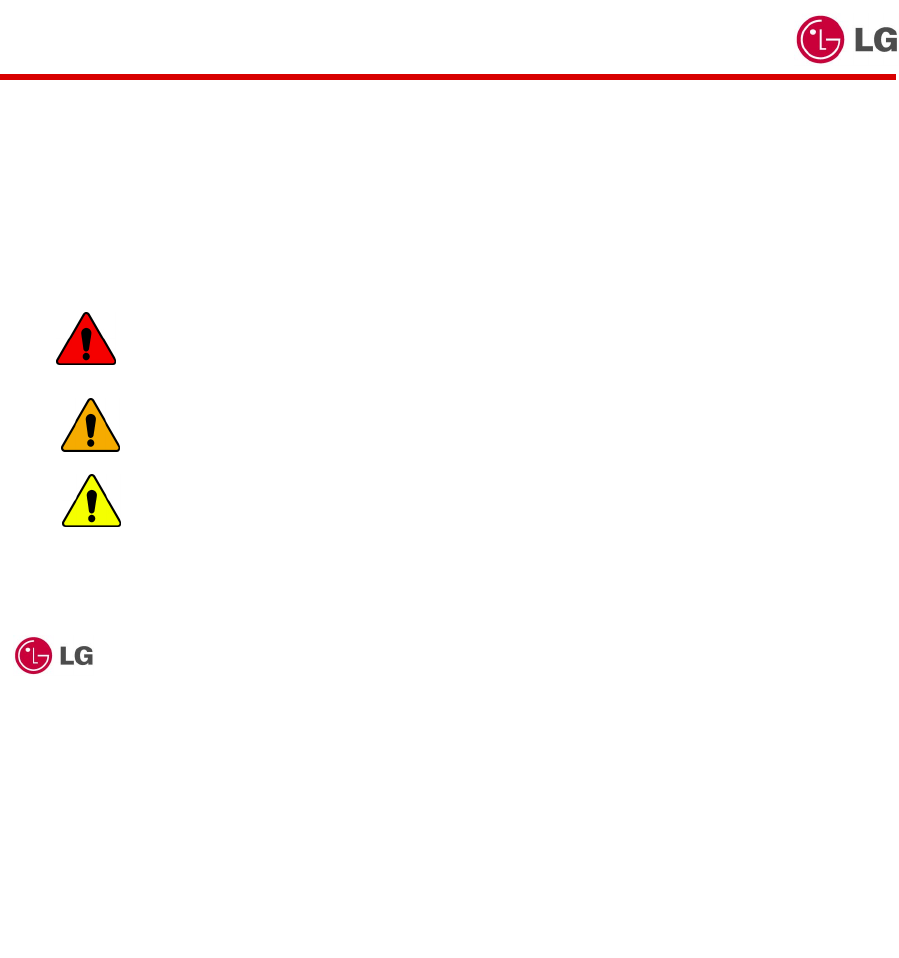
- 7 -
User’s guide
Thank you for using the LG product.
LG has manufactured and tested this product to provide you with a reliable computing
environment.
Please read this manual carefully before using the computer.
The following signs call attention to features and operations that may be dangerous to
the user. Follow the instruction closely to reduce the risk of physical harm or damage
to the equipment.
Danger: Not following the instruction will result in immediate death or
serious injury.
Warning: Not following the instruction could result in death or serious
injury.
Caution: Not following the instruction could result in minor or moderate
injury and/or damage to the product.
Microsoft, MS, MS-DOS, and Windows are trademarks of Microsoft Corporation in the
United States and/or other countries.
is a trademark of LG.
Copyright 2003 LG Electronics, Inc., DigitalMate Co., Ltd.
Information in this manual may include technical inaccuracies or typographical errors.
Images in this manual are for illustrative purposes only and may be different from the
actual product.
LG reserves the rights to make improvements and/or changes to the product without
notice.
Reproducing any or all of the information contained in this publication without written
permission is prohibited.
Your computer complies with the radio frequency and safety standards of any country
or region in which it has been approved for wireless use.
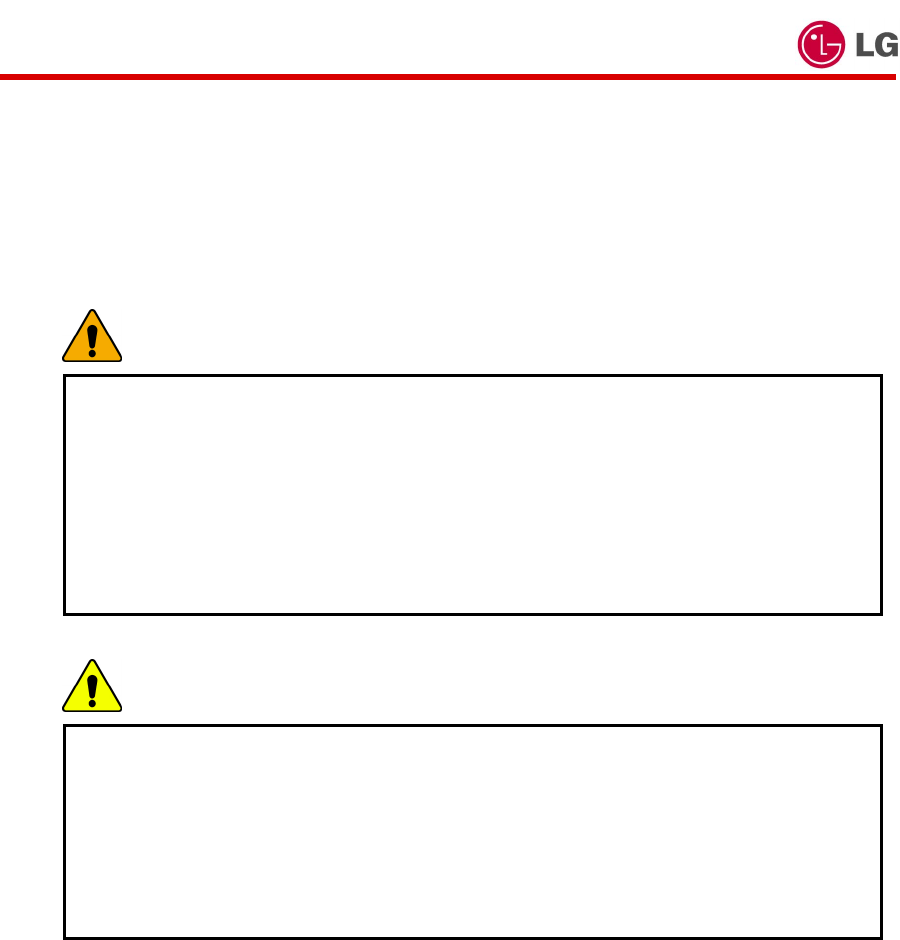
Important Safety Instructions
These safety instructions will ensure many years of safe enjoyment from the product.
Set up your computer on a flat, stable surface. (LG is not responsible for the problems
and damages caused by incorrect use of the computer in an unsafe environment.)
Selecting a place to work
Warning
Do not operate your computer near water; for example, in a bathroom or near a
swimming pool.
The computer may not function correctly, and there is the risk of electric shock.
Operate the computer within a temperature range of 50 to 95 degrees F (10 to
35 degrees C) and 20 to 80% of relative humidity.
Safely dispose of the packing materials, such as desiccant and plastic bags.
Children may swallow desiccant or suffocate from plastic bags.
Caution
Keep your computing environment clean and free of dust.
There is a risk of dysfunction to the computer.
Keep your computer away from electromagnetic fields.
Exposure to the electromagnetic field may result in loss of data in the hard disk
drive and/or damage to the LCD.
- 8 -
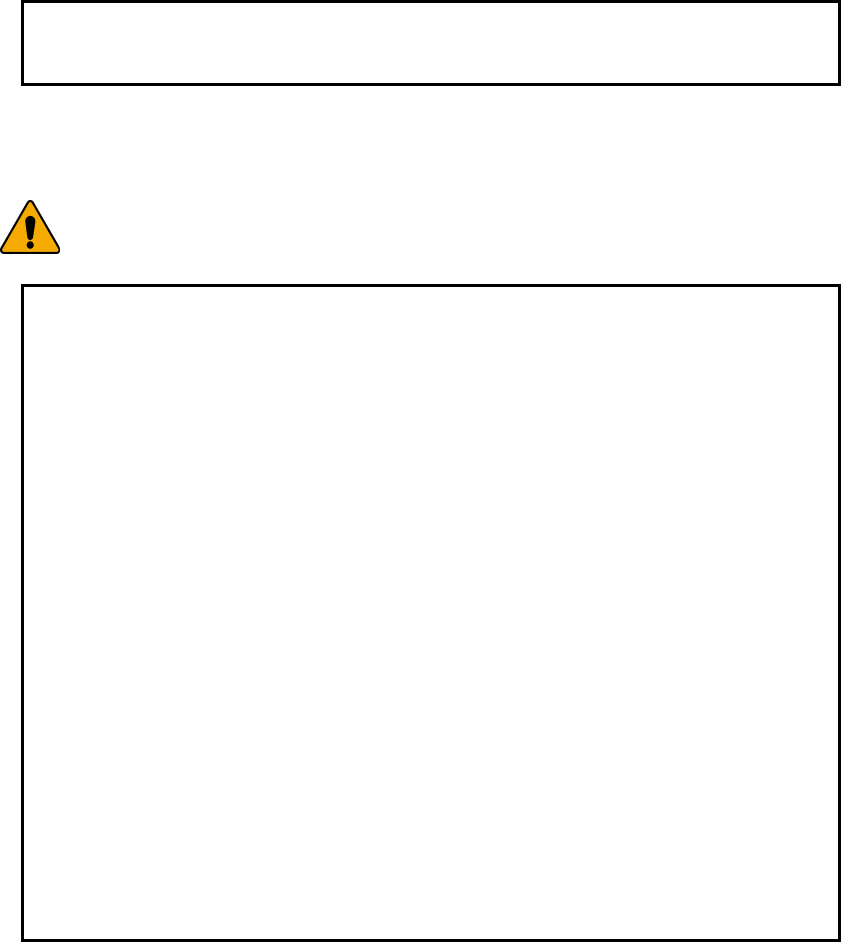
- 9 -
Do not block the fan louvers and leave enough space around the computer for
ventilation. The computer may overheat and result in fire or injuries.
Using the battery pack
Warning
Use only a battery pack recommended by LG.
Using a battery pack of a different type may result in explosion.
Keep metallic objects, such as keys and clips, away from the battery pack.
Objects that conduct electricity can short-circuit the battery pack and result in
fire and/or injuries.
Keep the battery pack away from heat.
There is a risk of explosion or fire.
Do not short-circuit battery terminals.
There is a risk of explosion.
Do not subject the battery pack to temperatures above 140 degrees F (60
degrees C).
There is a risk of explosion or fire.
Keep the battery pack away from children and/or pet.
There is a risk of injury and damage to the battery pack.
Do not put the battery pack in the water.
There is a risk of fire or damage to the batter pack.
Be cautious when handling the keen part of the battery pack hook.
It may hurt you.
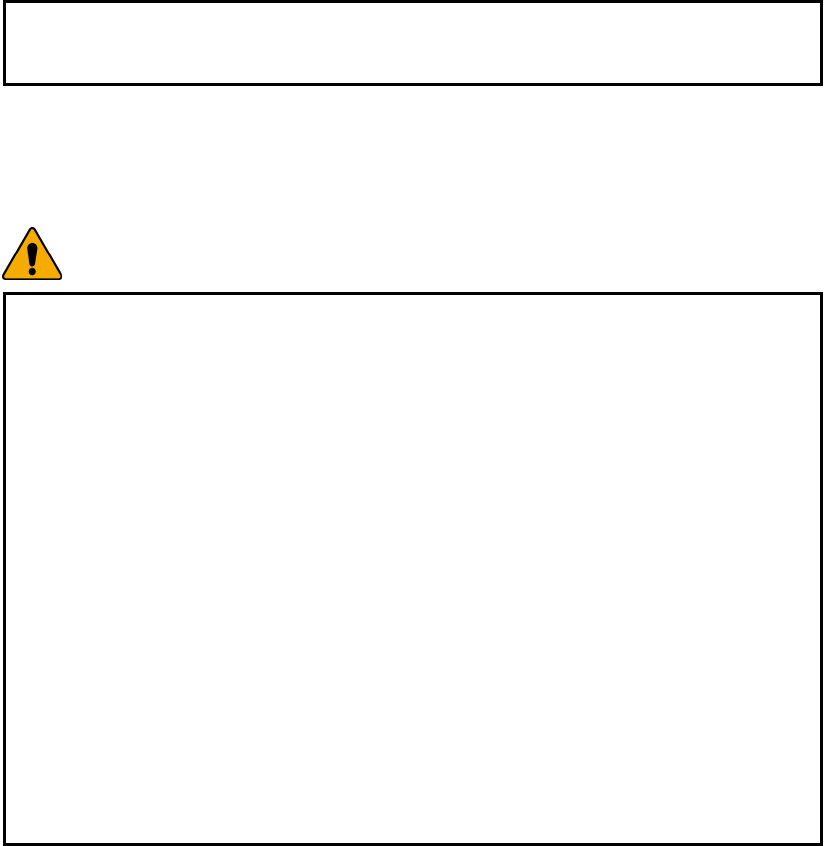
- 10 -
Lock the Notebook locker at the bottom surface.
There is a risk of battery damage.
Replacing and disposing of the backup (standby) battery
Warning
If the backup battery is incorrectly replace, there is danger of explosion.
The lithium batterry contains lithium and can explode if it is not properly handled
or disposed of.
Replace only with a battery of the same type.
)( .
.
) ( .
.
.
.
.
.
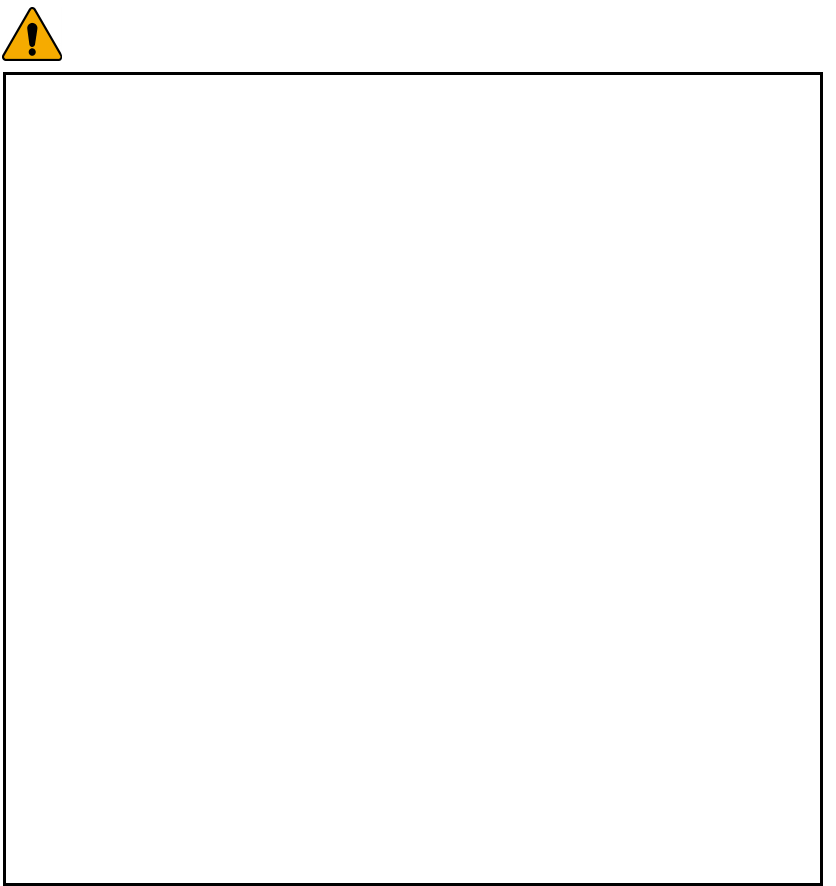
Connecting to an AC power source
Warning
Do not use loose or damaged power plugs.
There is a risk of electric shock or fire.
Use properly grounded outlet.
Connecting the computer to an outlet without proper grounding may result in
electric shock and damages to your computer.
Do not touch or grab the power plug with wet hands.
There is a risk of electric shock.
Hold the plug body when removing the power cord from an outlet.
There is a risk of fire and damages to the computer.
Use your computer at the proper voltage/current level indicated.
Supplying improper levels of voltage/current may result in electric shock, fire,
and/or damage to the computer.
If you hear a noise from the power cord or outlet, unplug the power cord
immediately, and contact the customer service for help.
There is a risk of fire or electric shock.
Make sure the power plug fits snugly into the electrical outlet.
Loose fit may result in fire.
Do not bend or place a heavy object on top of the power cord. Keep the children
and pets from damaging the power cord.
Damaged power cord may result in electric shock or fire.
Keep the power cord and plug clean and free of dust.
There is a risk of fire.
- 11 -

- 12 -
If an object or liquid enters the computer or an adapter, remove power cord,
battery, and any other cables from the computer, and contact the customer
service for help.
There is a risk of an electric shock, fire, or damage to the computer.
Before cleaning the computer, disconnect the power cord, battery, and any other
cables from the computer.
There is a risk of electric shock or damage to the computer.
Using the computer
Warning
For cleaning your computer, use mild detergent or computer cleaning products.
Be sure to dry completely before using the computer.
Using the computer without completely drying it may result in electric shock or
fire.
During a lightning storm, disconnect the power cord, telephone line, and LAN
cable from the computer.
There is a risk of electric shock or fire.
Do not place water, chemicals, or liquid of any kind on the computer.
Liquid of any kind entering inside the computer may result in an electric shock,
fire, or damage to the computer.
Do not connect the modem directly to a multi-line telephone.
There is a risk of fire or damage to the computer.
If you drop your computer, remove the power cord and battery pack, and then
contact the customer service for check up.
There is a risk of electric shock or fire.

- 13 -
Do not place a burning candle or cigarette on the computer.
There is a risk of fire.
If you see or smell smoke from the computer or adapter, turn off the computer,
remove the power cord, and then contact the customer service for help.
There is a risk of fire.
The LCD monitor’s fluorescent lamp include hydrargyrum.
Avoid direct contact with liquid from the broken LCD. If it spills into eyes or the
other parts of your body, wash it out several times with clean water. If you feel
something different, contact a doctor or a health administrator immediately.
Using the computer
Caution
Do not place an object, such as a pen or clip, on the keyboard.
If you close the LCD cover with an object on the keyboard, you may damage or
break the LCD.
Do not touch or scratch the LCD with sharp objects.
The LCD may be damaged.
Be sure to turn off the computer before closing the LCD cover.
The computer may overheat, and be damaged or deformed.
Do not exert excessive pressure on the LCD.
LCD is made of glass, and an excessive force can break the LCD.
Follow the instructions in the user's guide.
There is a risk of damage to the computer.
Do not place objects into the PC Card slot.
There is the risk of electric shock or injury.

- 14 -
Upon completion of any service or repairs, ask service technician to perform
safety checks.
Ignoring safety checks may result in electric shock or fire.
Use the Wireless LAN at least 5m away from a microwave oven or plasma lamp.
When using the Wireless LAN near a plasma lamp, use the channel 11, 12, or 13.
the connection may be unavailable or slow.
Keep the computer away from heat. The computer may deform and there is the
risk of fire.
When attaching an external device, make sure the connector from the device
and the port on the computer are of the same type.
There is a risk of damage to the computer.
Do not insert a damaged CD-ROM or floppy disk.
There is a risk of damage to the computer.
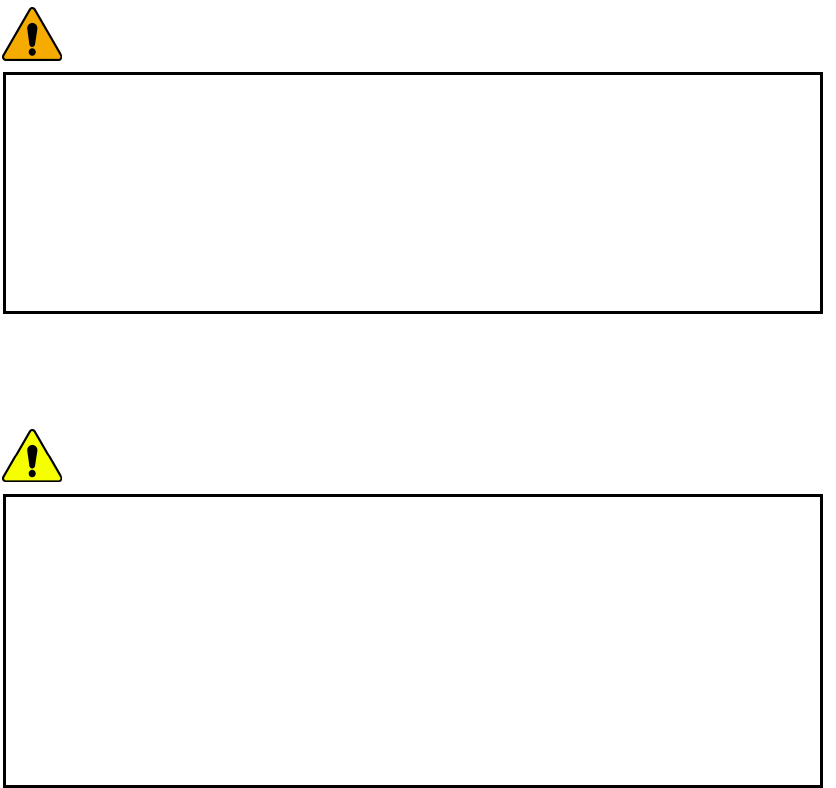
Upgrading the computer
Warning
Before disassembling the computer for upgraing purposes, turn off the power
and remove the power cord, phone line, and battery pack.
There is the risk of electric shock or fire. If you need to open the computer
cover, contact the customer service for help.
Keep screws and other small parts away from children.
Children may choke on a screw or other small part. If a child swallows a small
part, receive a medical care.
Upgrading the computer
Caution
Do not attempt to disassemble or modify the computer without consulting
customer service.
There is a risk of electric shock.
Replace only with the parts approved by LG.
There is a risk of fire and damage to the computer.
Consult with the customer service before connecting and using the computer
with any non-LG product.
There is a risk of damage to the computer.
- 15 -

Carrying and storing the computer
Caution
Before moving the computer, turn the power off and remove all the cables.
You may trip over the loose cables and fall.
When traveling on an airplane, follow the instruction by flight attendant.
Using the computer on an airplane may result in an airline accident.
Do not travel with LCD monitor open.
Do not expose your computer to the direct sunlight in a closed area such as
inside a car.
Prolonged exposure to high temperatures may deform the computer and also
result in fire.
- 16 -

Preventing data lose (handling hard disk drives)
Caution
Be cautious when handling the hard disk drive.
The hard disk drive is very delicate to any physical impact. Always make backups
for your data.LG is not responsible for the data lose caused by users.
The data on the hard disk or the drive itself may be damaged in the following
situations:
1. Exposure to a physical shock during the disassembling or installing process.
2. The computer is reset (rebooted), for example by power outage, while the
hard disk drive is operating.
3. Exposure to virus.
4. The computer is turned off during operation.
5. Exposure to a physical shock while the hard disk drive is operating.
To prevent data lose due to hard disk drive damages, always backup your data.
LG is not responsible for the lose of data.
- 17 -

Ergonomic information
Warning
Adjust the display position to avoid glare or reflections from overhead lighting.
The top of the display should be on or below the level of your eyes.
Keep your head and neck in an upright position.
Keep your forearms, wrists, and hands in a horizontal position.
Adjust your chair to keep your arms and hands in a comfortable position.
Using the computer in the same position for a prolonged period of time may
cause discomfort to your body.
Take short frequent breaks from working with your computer. No more than 2
hours of computing per day is recommended.
Stretch periodically to reduce muscular discomfort.
Check the volume level
Check if the volume level is too high before using headphones.
Do not use the headphones for a prolonged period of time.
- 18 -
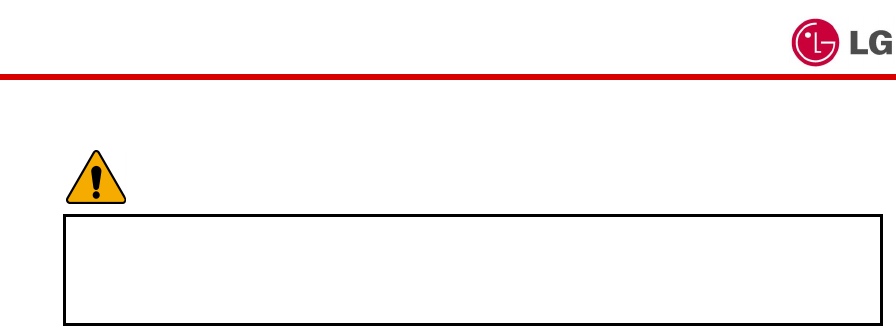
For Australian Users
Warning
For safety reasons, only connect equipment with a telecommunications
compliance label. This includes customer equipment previously labelled or
certified.
- 19 -
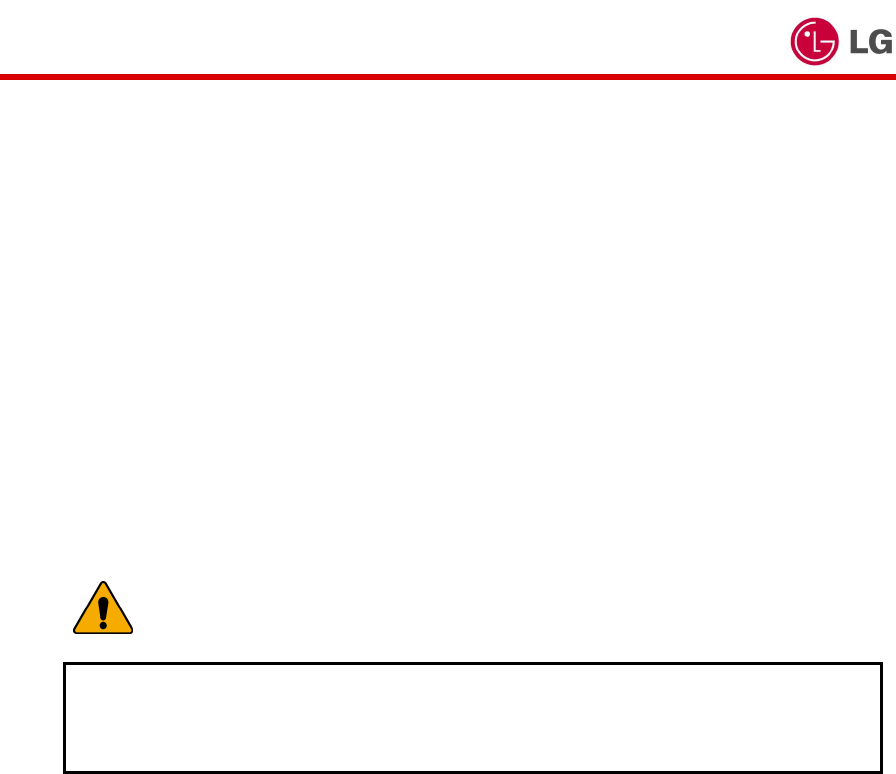
- 20 -
Laser compliance statement
An optical storage drive (device), such as a CD-ROM, CD-RW, DVD-ROM drive,
which can be installed in this unit is a laser product. The driver’s classification
label is on the surface of the drive as shown below.
CLASS 1 LASER PRODUCT
LASER KLASSE 1
LUOKAN 1 LASERLAITE
APPAREIL A LASER DE CLASSE 1
KLASS 1 LASER APPARAT
The drive is certified by the manufacturer to comply with the requirements of the
Department of Health and Human Services 21 Code of Federal Regulations (DHHS
21 CFR) Subchapter J for Class I laser products at the date of manufacture.
In other countries, the drive is certified to conform to the requirements of IEC825
and EN60825 for Class 1 laser products.
DANGER
Do not open the optical drive unit: no user adjustments or serviceable parts are
inside. Use of controls, adjustments, or the performance of procedures other
than those specified might result in hazardous radiation exposure.
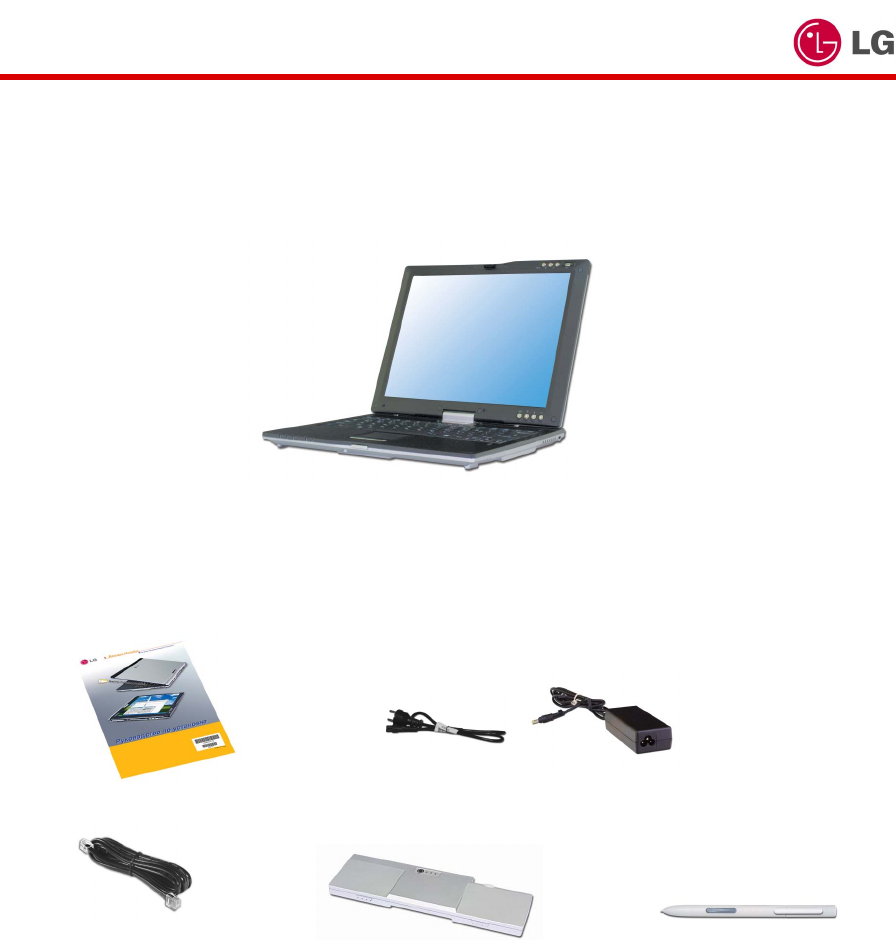
Overview
Package contents
The following items are included in the package. Match the items on this list with
the items in the box. Some items may look different from the pictures.
LT 20
Note: Make sure you have the correct AC adapter before connecting it to the
computer.
Installation guide power cord/AC adapter (65W) (Using offered cable)
- 21 -
Modem cable Battery Pen (offered Full size digital pen)
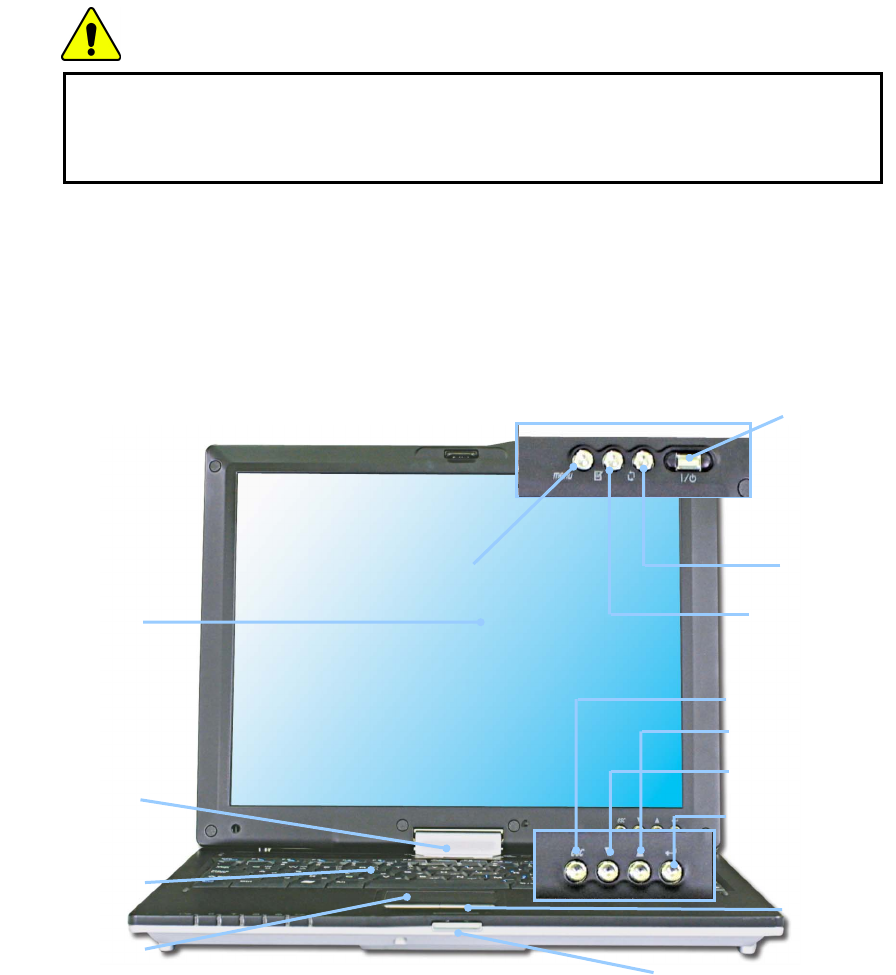
Caution
When cleaning your computer, use cleaning products manufactured specifically
for computing equipment. Using abrasive chemicals, such as paint thinner,
benzene, or alcohol, may damage your computer.
Components
Learning the components and their functions helps you to use the computer more
easily and thoroughly.
Front view
- 22 -
Windows
Journal
button
LCD display
panel
rotation
axis
Enter button
Down button
Up button
LCD
Power switch
Keyboard
TouchPad
button
LT20
TouchPad
ESC button
ez menu button
Screen
rotation
button
Latch button
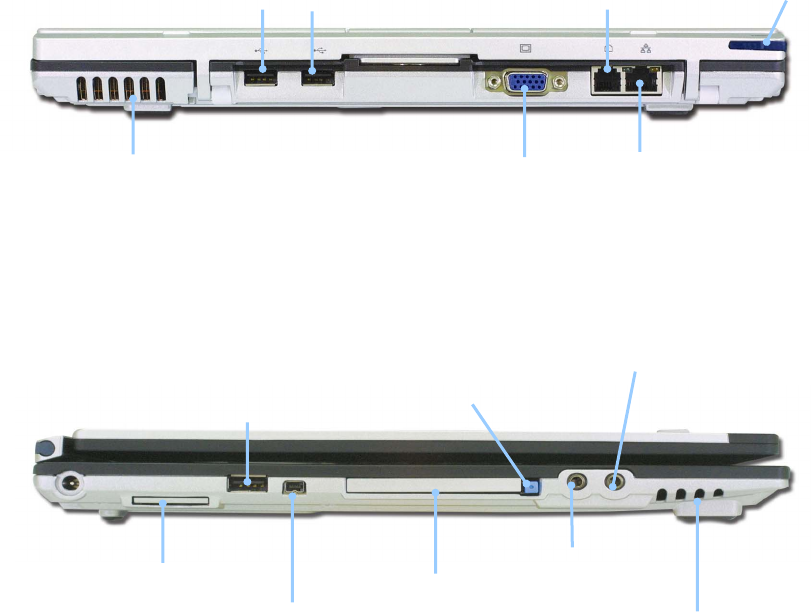
Note: ez menu button, Windows wordpad button, LCD rotation button, Power
switch, Esc button, Up/Down button, and Enter button are coated for preventing
static electricity purposes.
Rear view
Modem Port Pen (small)
USB(Universal Serial Bus) port
LAN Port
VGA port
Fan louvers
Left view
Microphone jack
PC Card eject button
USB port
Headphone
jack
SD memory Card
slot IEEE
1394 Port
PC Card slot
Built-in speaker
- 23 -
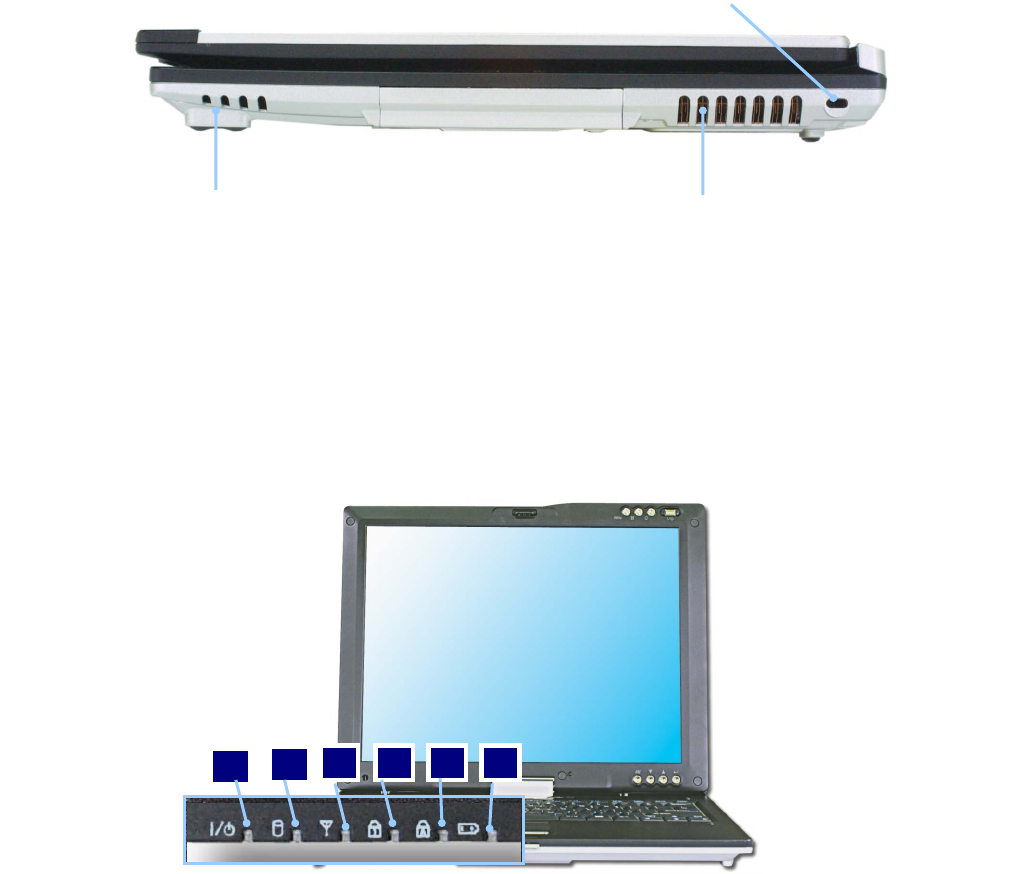
Right view
Key hole (Kensington Lock)
Built-in speaker
Fan louvers
Security key hole (Kensington Lock): User can attach a separately purchased
chain lock into the security keyhole and connect it to a fixed object to prevent a
notebook theft.
Status indicators
Note: Some models may look different from the picture below.
1 2 5 4 3 6
- 24 -
- 25 -
1. Power: Power status indicator indicates the following status of the
computer.
Green: The computer is turned on.
Off: The computer is turned off or is in hibernation mode.
Blinking: The computer is in standby mode.
2. Drive in use: Drive in use indicator lights up when data is being written to
or read from the hard disk.
3. Wireless activity indicator: Wireless activity indicator indicates the
following.
Off: The wireless card does not have the power or RF is off.
Blinking: The wireless client is not associated with the network. Slow
blinking (3-4 seconds interval): the wireless card powered on and
attempting to connect.
Fast blinking: The wireless card transmitting and/or receiving data by the
rate depending on blinking speed.
4. Num lock: Num lock indicator lights up when the combination of the Fn and
Num lock key is pressed. When this indicator lights up, you can use the
embedded numeric keys. (To use the numeric keys, you must enable the
Internal Keypad setting under the Advanced menu in the BIOS Setup
Utility)
5. Caps lock: Caps lock indicator lights up when the Caps lock key is pressed.
When this indicator lights up, you can type capital letters without pressing
the Shift key.
6. Battery: Battery status indicator indicates the following status of the
battery.
Off: The computer is not connected to an AC adapter and the battery is
discharged.
Amber (orange color): The computer is connected to an AC adapter and the
battery is charged. (0% ~90%)
Amber and Green (blinking) : The battery is nearly full charged (90~100%)
Green: The computer is connected to an AC adapter and the battery is fully
charged
Red: There is some problem in the battery.
Green blinking: The battery is fully discharged.
Green blinking for three times: The battery is fully discharged / Pressing
the power button when system is off
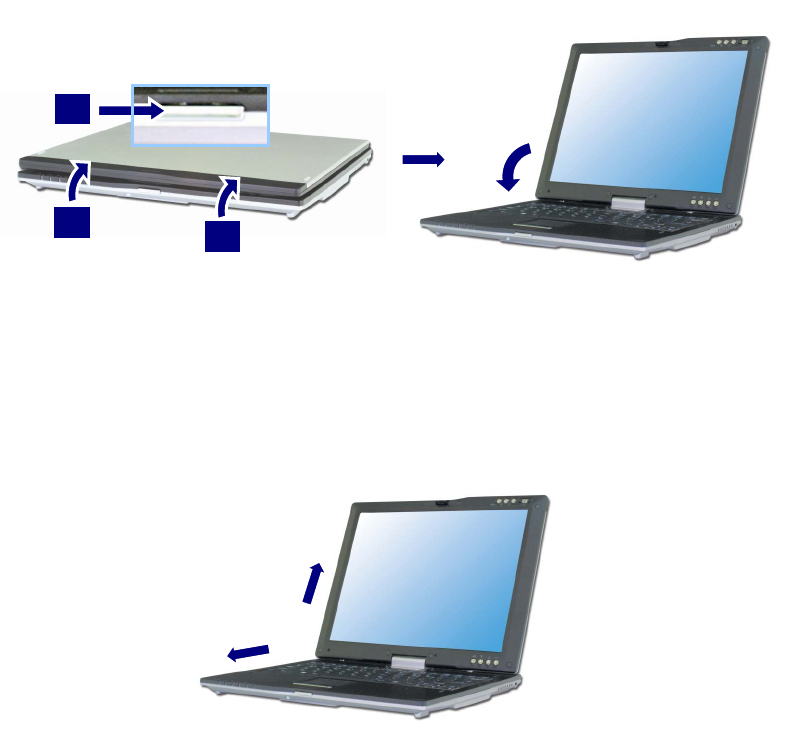
Using LCD panel
LCD panel has the function of 180° rotation switching as tablet PC,
and can be laid upward on the keyboard.
Opening LCD Panel
Push the latch button in the direction of the arrow1, and open the display
panel 2. Adjust the slope of the display panel for comfortable viewing.
1
2
2
Using Tablet mode
When using tablet mode, follow orders as below.
1. Open up LCD panel till the keyboard is 90°.
- 26 -
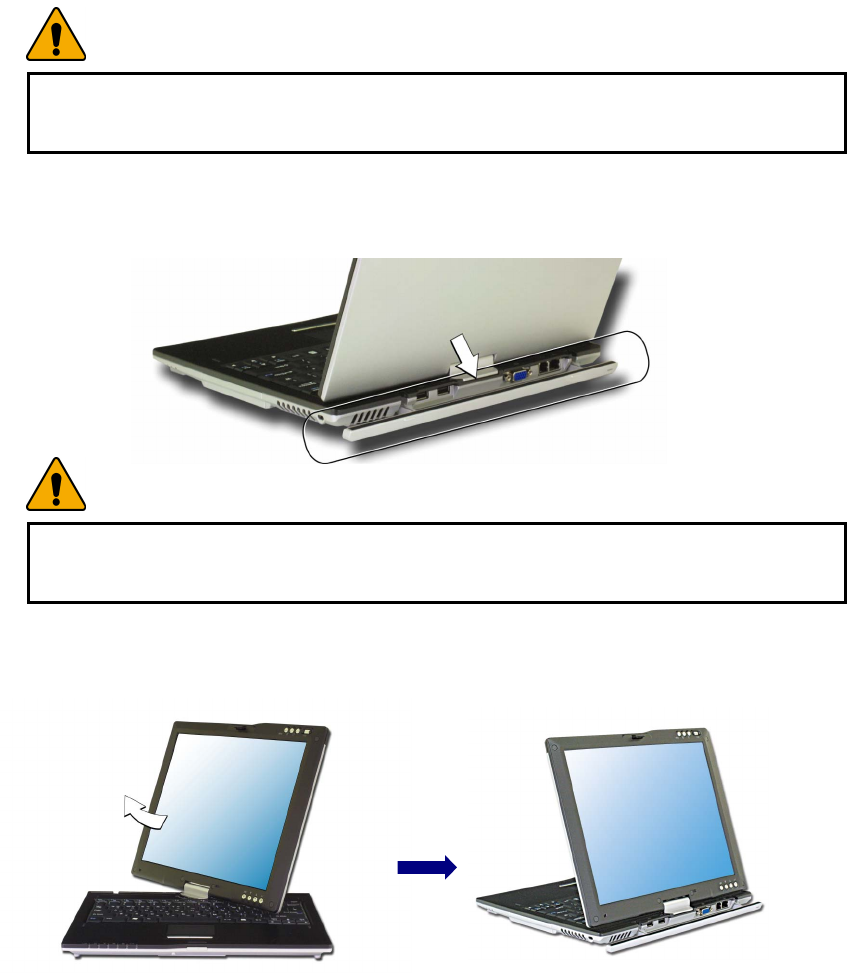
Warning
Do not prevent fan louvers when using tablet mode.
Internal temperature rise can be a risk of damage to the computer.
2. Push down the tilt at the back of computer as direction (white arrow).
- 27 -
Warning
Do not make LCD rotate without pushing down the tilt.
There is a risk of damage to the computer.
3. If LCD panel has 90° on the keyboard, rotate LCD as clock-wise to make an
opposite side.
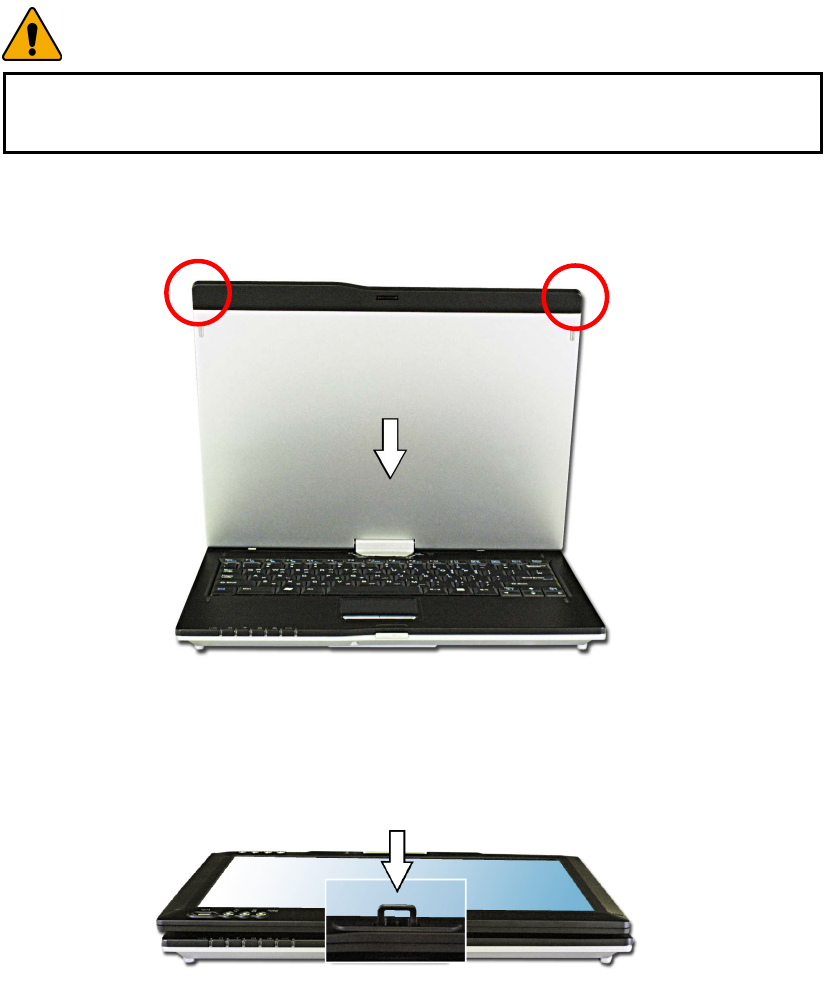
Warning
Follow up defined orders.
There is a risk of LCD Panel rotation axis crash when direction is different.
4. Pull down LCD panel to table PC body as direction (white arrow) with holding
at the upper edge of LCD.
5. Fix the latch switch on LCD panel after folding as close to the keyboard
completely.
- 28 -
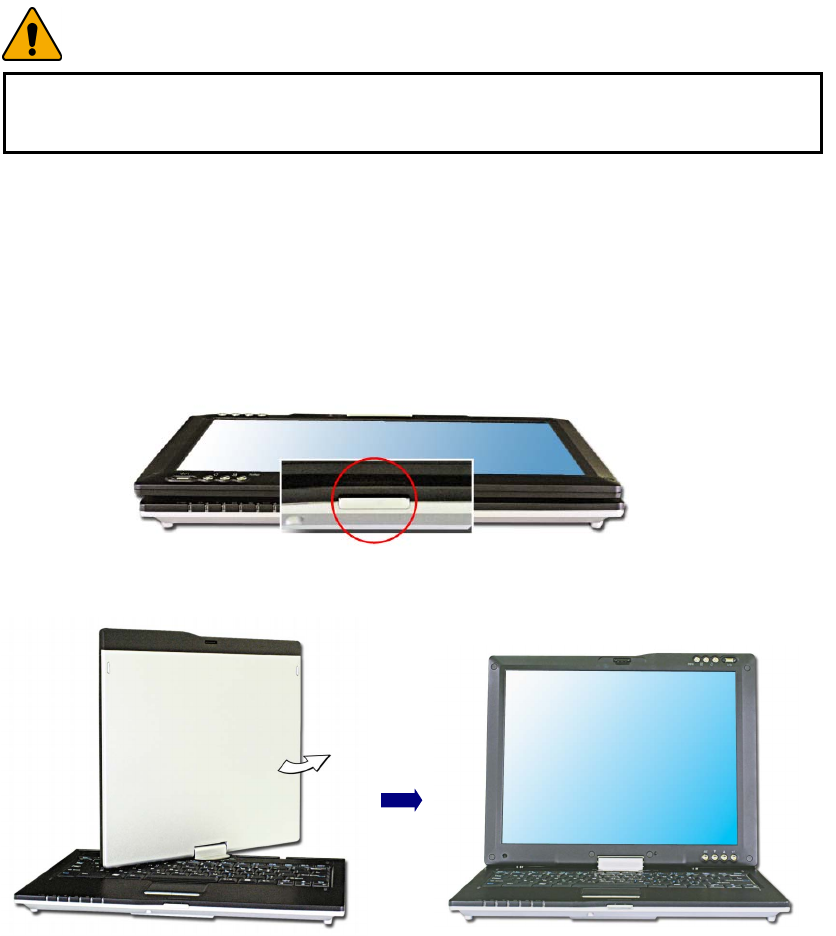
Warning
When using LCD as tablet mode, it can cause the button error.
When using tablet mode, do the lock device before using the computer.
Using notebook mode
1. If using notebook mode, lift up till LCD panel has 90° on the keyboard after
pushing down the latch button.
2. If LCD has 90° on the keyboard, make it rotate as counter clock-wise.
- 29 -
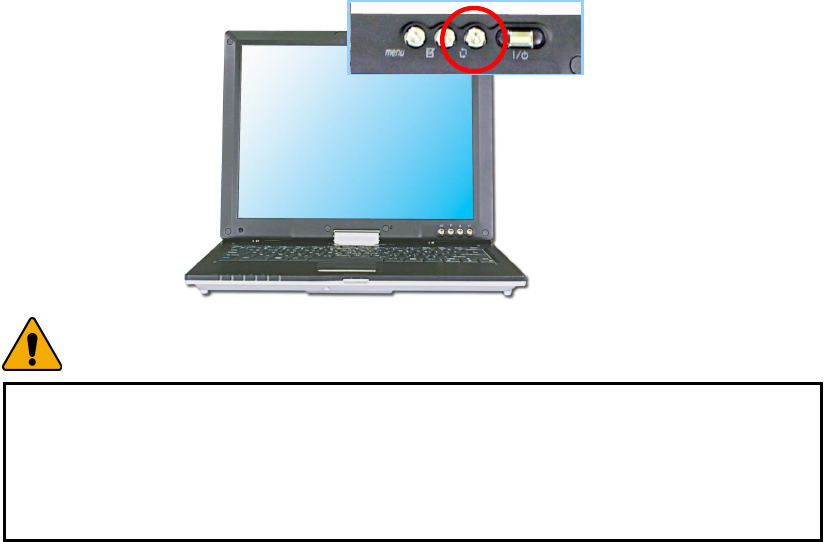
3. Adjust the slope of the display panel for comfortable viewing after making a
rotation completely.
Using Screen rotation
Screen rotation is the function can modify the direction of Desktop screen as the
unit of 90°. Push the [Screen rotation] button on LCD panel.
- 30 -
Warning
Do not modify screen resolution and color when using screen rotation.
Put the screen back in its place before modifying screen resolution and color.
When using screen rotaton, application program (involved screen saver) might
have problems as velocity display slow.
When turning ON/OFF, screen rotation is not working.
When modifying screen rotation button setting up
1. Go to [Control Panel]-[Tablet and Pen Settings]. Click [Change] at [Display
tab].
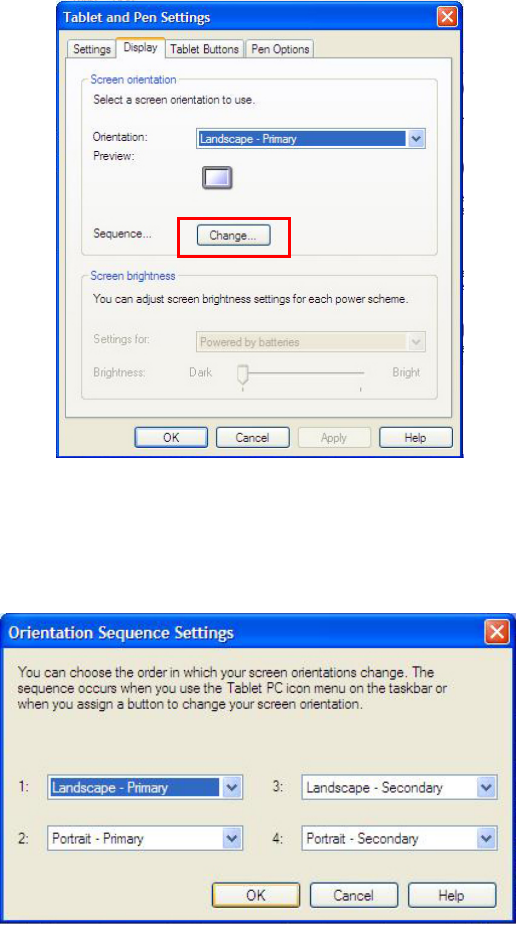
- 31 -
2. Modify the screen direction at [Orientation Sequence Settings], and click
[OK].
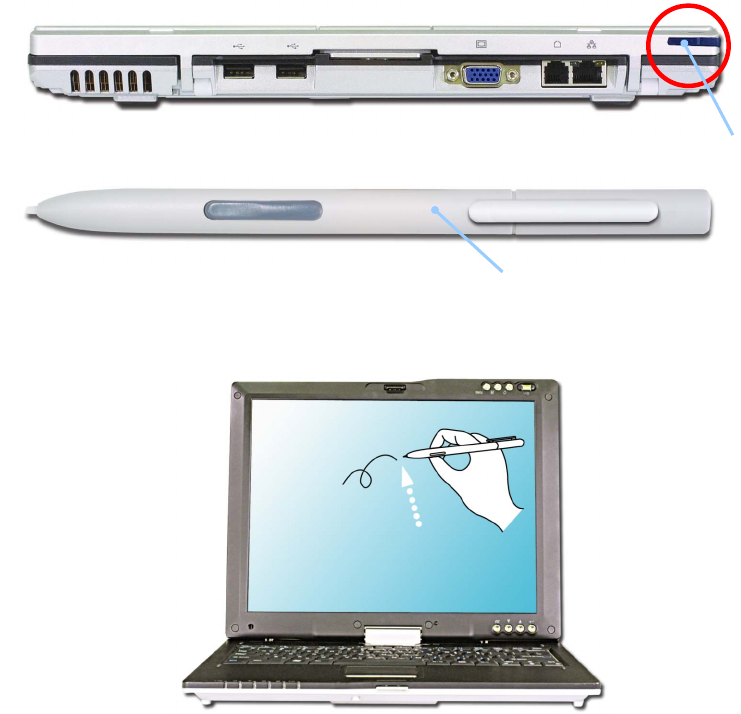
Using Touch panel
It is comfortable pointing device for using mouse pointer directly on the screen.
Electromagnetic induction system touch panel attached on LCD panel is
operated by offering pen, or attached pen at tilt.
It is easy and fast operation on the screen.
Use an attached pen at tilt, or offered pen from the product.
Pen
Pen (offered)
2. When moving a pen, pointer moves toward the direction of a pen.
- 32 -
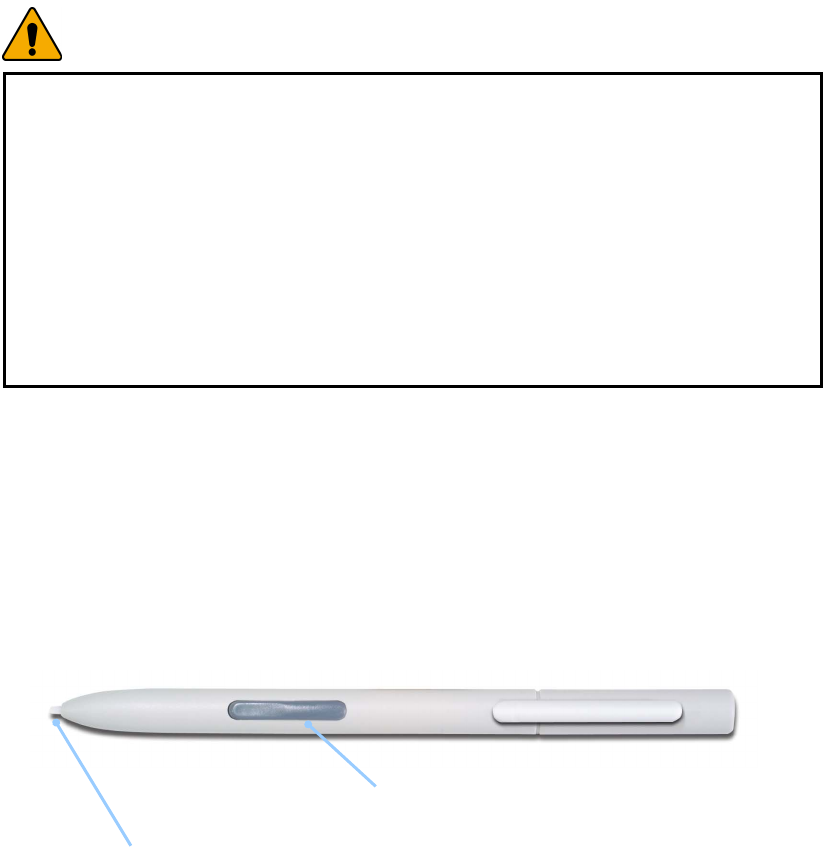
Warning
Using a pen involved at tablet PC is strongly recommended. If using a pen is not
from the product, it can be seriously a risk of damage to the computer.
Do not put a pen strength on the screen. It is a risk of damage to touch panel, or
LCD.
Puddle phenomenon appears on LCD is caused by being pressed down from
using a pen
This is not serious phenomenon because it is restored to the former state
automatically.
If the screen is distorted, or not restored to the formaer state, contact to
Customer Service.
Put a pen back in its place after using.
Using Pen (attached pen in tilt / offered extra pen)
These pens have functions of controlling buttons, icons, and each application
programs as using the mouse on the desktop.
When using the program has writing recognition, these are useful to write down
on LCD directly, and treat as a drawing tool.
Mode button
Pen point
- 33 -
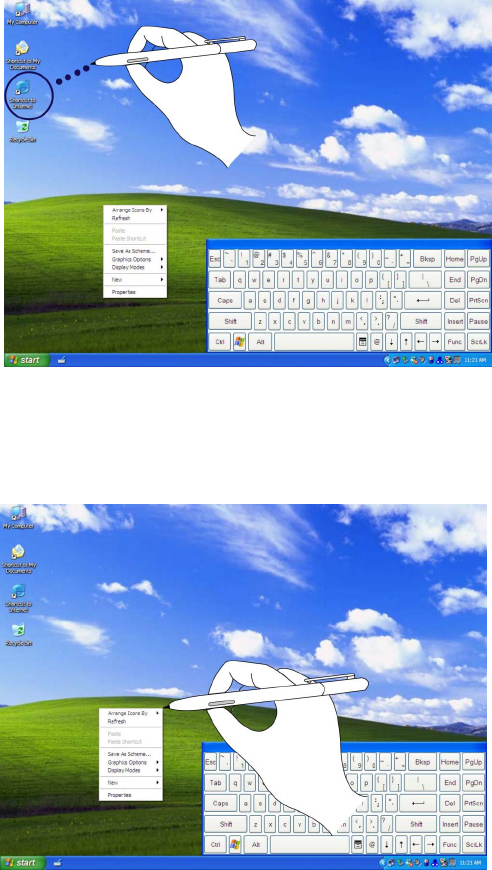
Tab
Click one of icons on the desktop screen. The same function as left click.
Right tab
Tab the screen with pushing button on the pen.
The same function as right click.
- 34 -
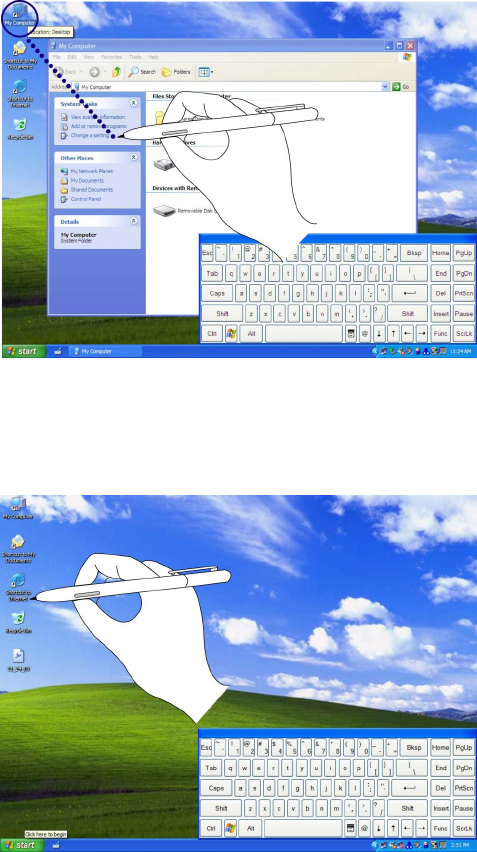
Double tab
The same function as double click.
Point
Touch on the screen lightly.
- 35 -